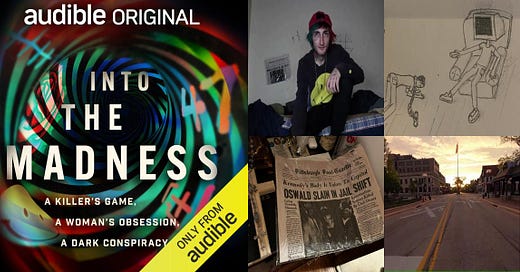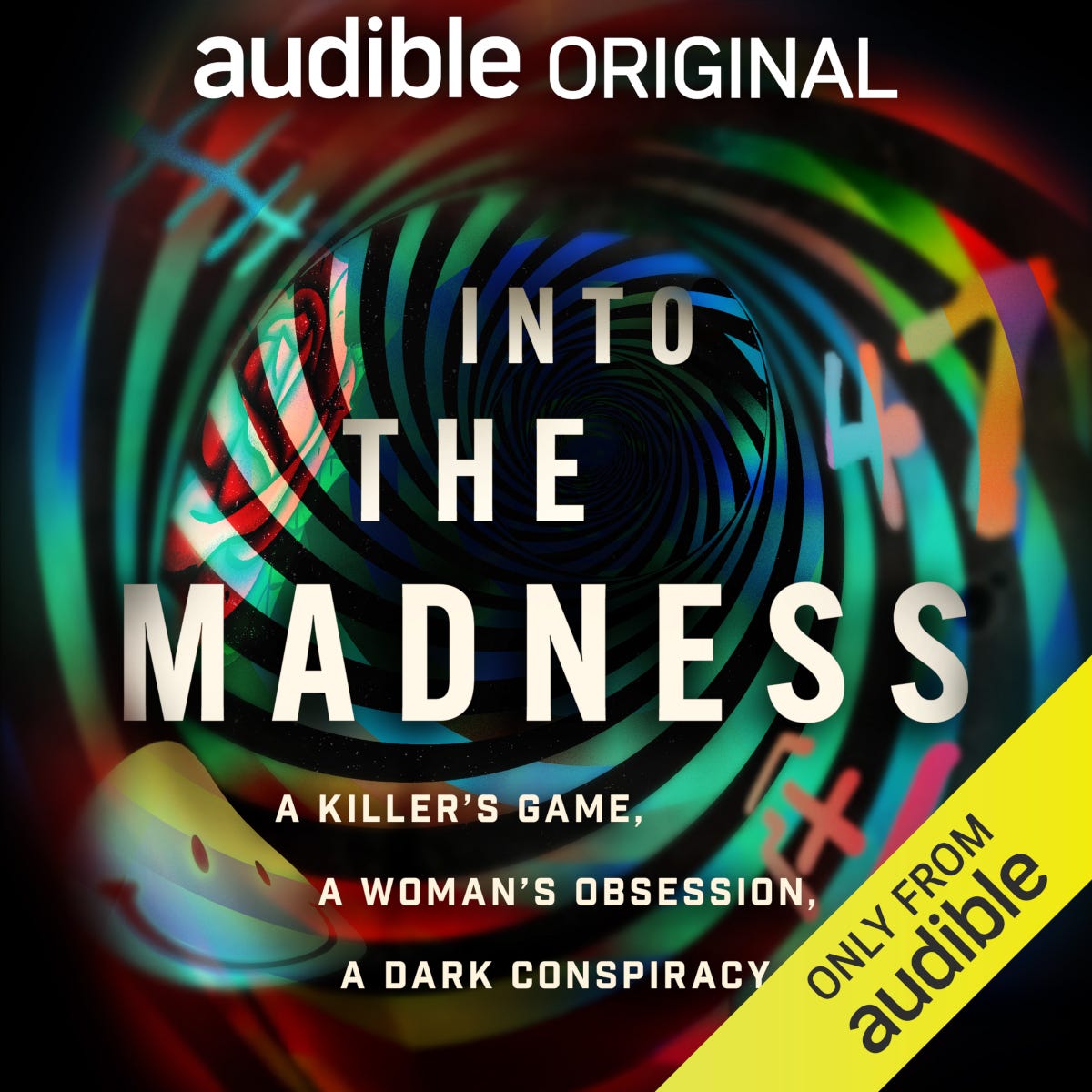The Shooter Who Tried to Create a Conspiracy Theory
"Into the Madness," now available on Audible, investigates a mass shooting outside Chicago — and what it reveals about America’s obsession with conspiracy theories.
Conspiracy theories are at the heart of the 2022 mass shooting in Highland Park, Illinois, where a gunman opened fire on a Fourth of July parade, killing seven people and wounding dozens more.
In Into the Madness, my new seven-part Audible Original series, I investigate how online games and conspiracy theories played a role in the attack. The full series is available now on Audible.
Robert “Bobby” Crimo III, the accused shooter, is set to stand trial next week.
In the series, I uncover new details about Crimo’s activities before the shooting, including his participation in an unusual, ongoing Skype call and his involvement in a fringe website trafficking in violent videos — both of which drew the FBI’s attention during the investigation. I also reveal how Crimo’s motivations were rooted in a desire to turn his crime into a game — one designed to seed a conspiracy theory about the attack.
As with my previous Audible Originals, I use one story to explore something much larger about our world.
In American ISIS, I investigated how radicalization happens through the story of a Floridian who joined the Islamic State terrorist group in Syria. In Hold Fast, I examined the erosion of First Amendment protections through the story of “adult ads,” alternative newspapers, and Backpage.com. In Pulse, I explored the flaws in the FBI’s counterterrorism strategies by revealing the bureau’s failures to prevent the Pulse nightclub shooting.
Now, with Into the Madness, I use the story of the Highland Park shooting to explore how conspiracy theories distort our shared reality — and what happens when those conspiracies inspire mass violence.
How This Project Started
The idea for this project began to take shape in the summer of 2021. About six months after the January 6 Capitol riot, a conspiracy theory bounced around right-wing media: that the attack on the U.S. Capitol was an FBI setup. The conspiracy theory claimed that the FBI secretly used informants to inspire and organize the Capitol riot.
On June 15, 2021, then-Fox News host Tucker Carlson amplified this fringe theory and took it further by distorting facts to support it. He cited my book, The Terror Factory, as supposed pretextual evidence that the FBI had orchestrated the January 6 attack:
“Trevor Aaronson’s book The Terror Factory analyzed every terrorism prosecution from 2001 to 2013. Aaronson found that at least 50 defendants were on trial because of behavior that the FBI had not only encouraged, but enabled. FBI agents were essentially the plotters in these crimes. They made the crimes crimes.”
You can listen to Carlson’s monologue here, starting around the five-minute mark:
While my 2013 book documents how the FBI used sting operations and informants to manufacture terrorism cases, it does not in any way support Carlson’s claim that the FBI orchestrated January 6. In fact, the FBI’s history suggests the opposite: the more people involved in an orchestrated plot, the more likely the FBI is to botch it (see: Liberty City Seven, Operation Bo-Tox, Wolverine Watchmen). The idea that the FBI could secretly coordinate 2,000 people to storm the Capitol is laughable.
Some FBI informants were present on January 6, which isn’t surprising given the agency’s infiltration of extremist groups like the Oath Keepers and Proud Boys. But there’s no evidence they encouraged or facilitated the attack. Courtroom testimony revealed that some informants failed to report on the Proud Boys at all — because their FBI handlers were more focused on what the group knew about anti-fascist organizations than on what they were planning for January 6, 2021.
Despite widespread debunking — including my own article for The Intercept — the “FBI did it” conspiracy theory has only grown. A recent poll found that one in four Americans believes the FBI was behind the January 6 attack.
The FBI and Conspiracy Culture
Conspiracy theories involving the FBI are not new. The bureau has been accused of playing a role in events ranging from the assassination of President John F. Kennedy to the Oklahoma City bombing, the 9/11 attacks, and the Boston Marathon bombings. But in the years following the 2016 election, FBI conspiracy theories became increasingly partisan and more deeply embedded in mainstream political discourse.
Right-wing media began advancing the idea that a “secret society” inside the FBI was working to undermine President Trump. Some far-right figures went further, claiming that liberal donor George Soros controlled the bureau’s operations overseas — a claim that gained traction in certain conservative and conspiracy-driven circles.
Among the most insidious conspiracy theories was one promoted by Alex Jones and his followers: that mass shootings are staged or orchestrated as part of a secret plot to justify new gun control measures. Jones had long peddled this claim — including his notorious falsehoods about the Sandy Hook massacre — but by the 2020s, the idea had become a staple of far-right discourse.
Laura Loomer, a political provocateur who traveled with President Trump during his 2024 campaign, pushed the conspiracy theory even further, claiming that “the FBI works with the Democrat Party to carry out mass shooting false flags so that they can actually push for gun control.”
By 2022, it was clear to me that FBI conspiracy theories had reached a new and dangerous level of cultural and political influence. I wanted to document not only how they spread but also the real-world consequences of this distorted thinking. But how could I tell that story?
Then came July 4, 2022.
The Highland Park Mass Shooting
During a Fourth of July parade in Highland Park, Illinois, a gunman armed with an AR-15-style rifle opened fire on the crowd, killing seven people and injuring dozens more. Later that day, police arrested Bobby Crimo, a 21-year-old who made lofi hip-hop under the name “Awake the Rapper” on SoundCloud. During an interrogation, Crimo offered a vague confession to an FBI agent and a local detective.
Crimo had left behind a digital footprint that was enormous — including dozens of videos, a discography, and a self-published book filled with seemingly random numbers. Internet sleuths quickly began archiving his material before platforms took it down.
Some of those internet sleuths noticed references to the FBI in this online material. In photos, Crimo wore an “FBI” hat. In a livestream, he signed off with, “Goodbye, Mr. FBI Agent.”
A theory quickly surfaced online, claiming the FBI was somehow involved in the shooting. A few internet sleuths even contacted me, eager to share their suspicions and enlist my help. I ignored them. I had no interest in chasing their unfounded speculations about the Highland Park mass shooting.
Then, months later, I received another message — this time from a woman who said she was a close friend of Crimo’s. She had recorded more than 48 hours of phone calls with him from jail.
She told me she believed his crime was somehow connected to an Alternate Reality Game (ARG) that Crimo had created before the shooting. She thought his self-published book of numbers contained a hidden message — a cipher tied to his ARG. She suggested that if we could decipher the book using clues from the ARG, we might uncover some sort of message related to the attack.
Over time, this woman became a participant in Crimo’s game, recording and distributing a jailhouse video in which the accused mass murderer claimed the shooting was part of an FBI operation:
Crimo’s attempt to manufacture a conspiracy theory around his alleged crime reveals how deeply online conspiracy culture can warp reality, even in the most violent and tragic ways.
That’s the story I tell in Into the Madness — how conspiracy theories take root, spread, and lead to real-world violence.
How to Listen to Into the Madness
Into the Madness is now available on Audible.
If you don’t have an Audible subscription, I’m offering newsletter subscribers codes to listen to the series for free. Fill out this form to request one. Codes will be sent out later this month or in early March, while supplies last.
You can also start a free 30-day trial at Audible.





